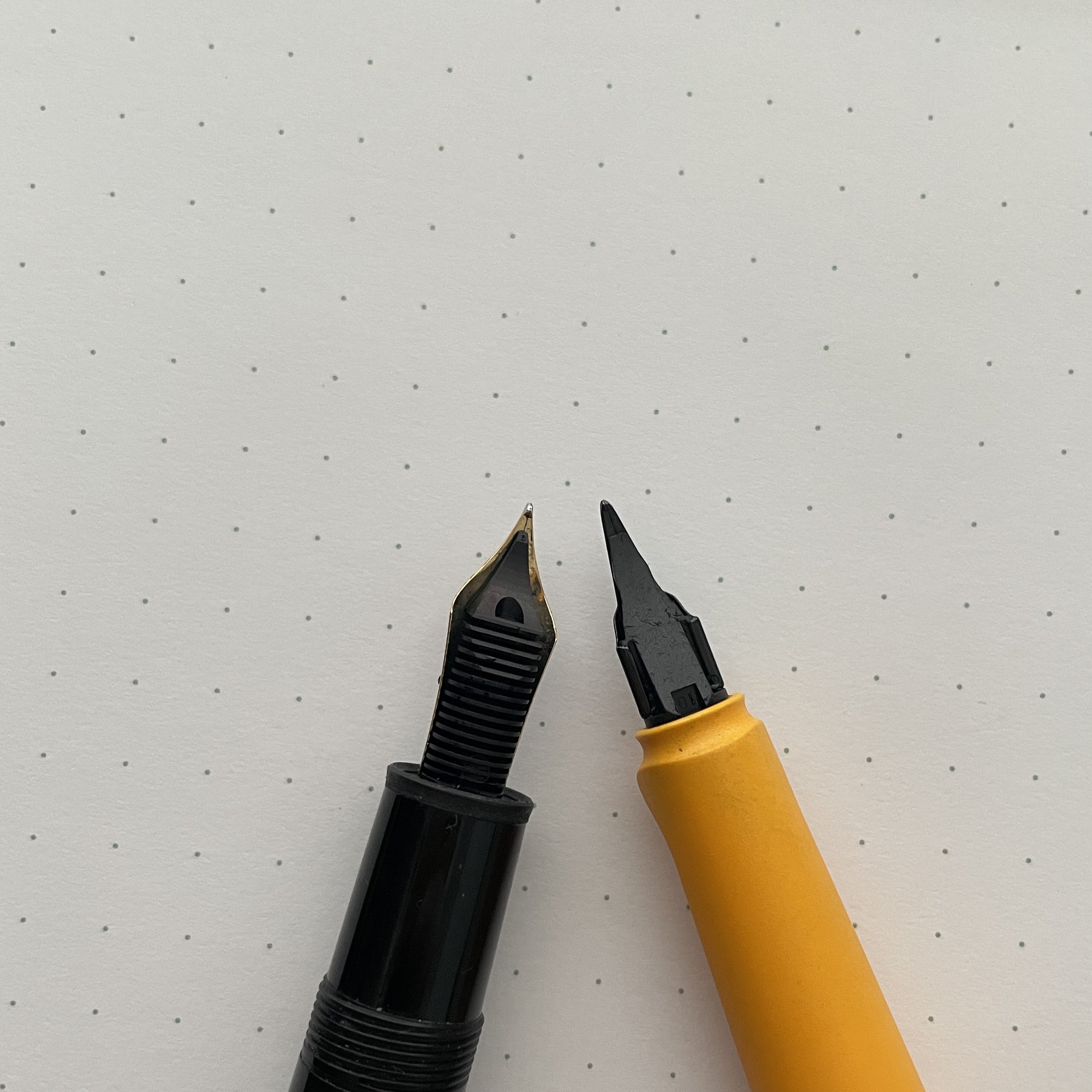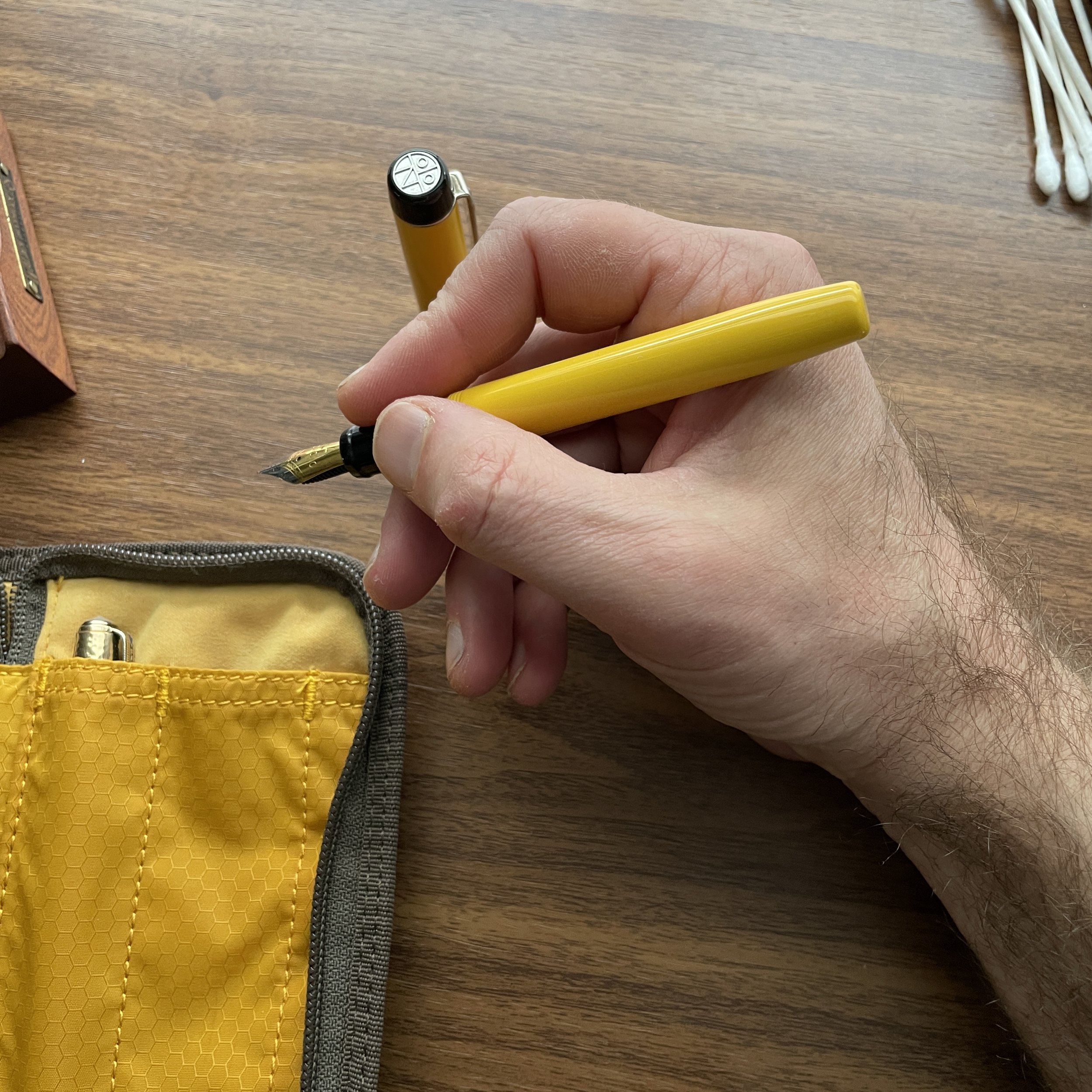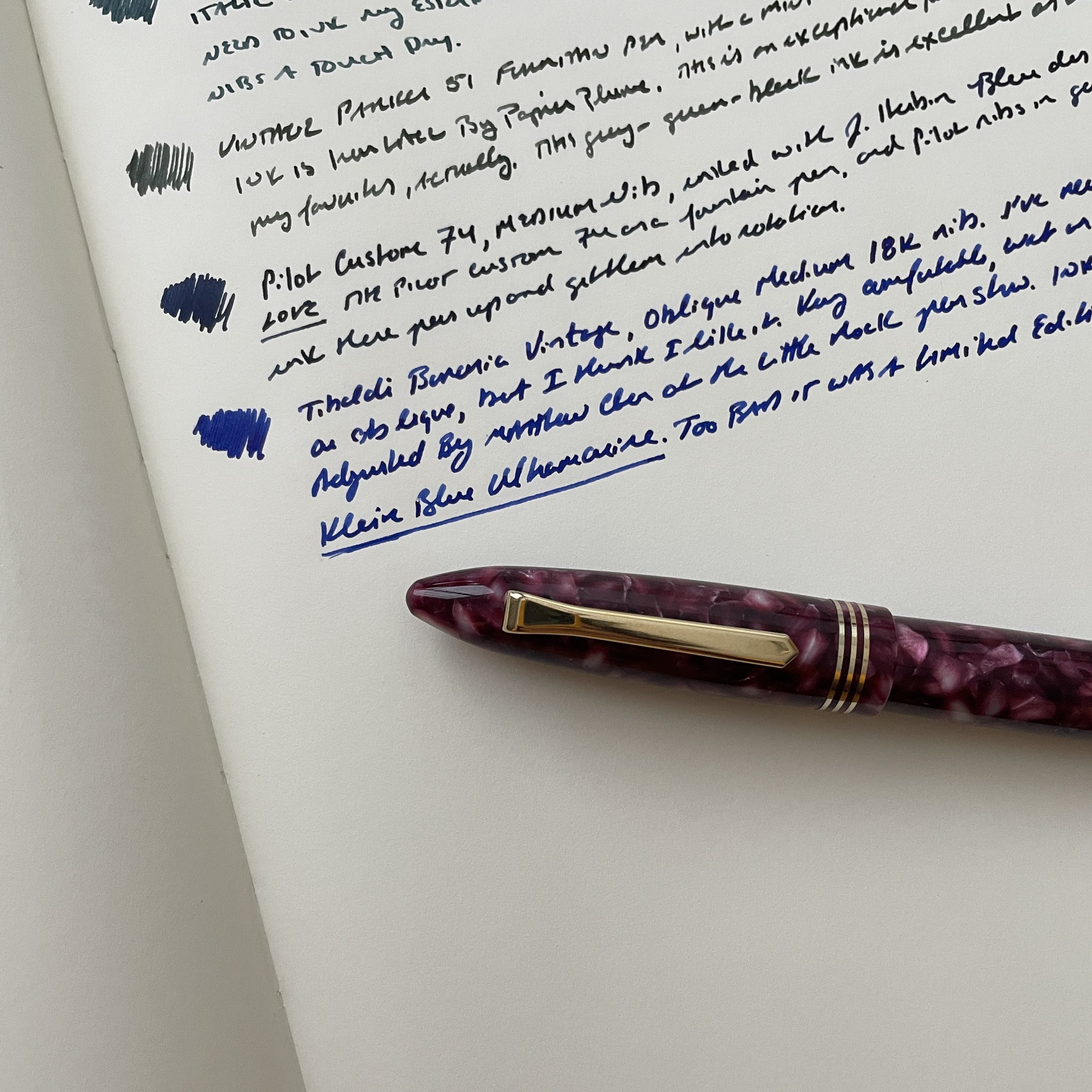The Pilot Vanishing Point might be the most popular, and the Custom Urushi and Custom 845 the media darlings that receive a lot of attention, but the pen that I would identify as the true “workhorse” of Pilot’s lineup, and which - if I were in charge - I would personally consider the flagship, is the Pilot Custom 823. Frankly, I’m somewhat embarrassed to have not given the Custom 823 the formal “Workhorse Pen” review treatment at this point in my career, so here we go!
A flashy pen it is not: The Pilot 823 in Amber (left) and Smoke (right). These two transparent demonstrators are different colors, but when inked it can be somewhat difficult to tell the difference.
The Custom 823 Follows The Workhorse Pen Blueprint
When designing the Custom 823, Pilot seems to have followed my “workhorse pen” blueprint to the letter: (1) an excellent nib; (2) a well-build, balanced pen body that can be used either posted or unposted; (3) an understated design that, while of course lets anyone know you are using a fountain pen, can’t be described as flashy; and (4) a reliable, high-capacity filling system. Over the years, Pilot has taken some flack for not “updating” the design on the Custom 823, and it remains available in the U.S. in exactly two colors: transparent “Smoke” and transparent “Amber,” both with gold trim. There have been no limited or special editions that I’m aware of other than one or two Japan-only exclusives, both of which sold out quickly and now command steep premiums on the secondary market.
The Pilot Custom 823 features a 14k No. 15 nib, which is roughly the same size as a JoWo No. 6.
Why Do I Still Like This Pen So Much, Nearly 7 Years Later?
I first reviewed the Pilot Custom 823 nearly 7 years ago, in August of 2016, after purchasing the Amber pen at the Atlanta Pen Show that same year. While the design of this pen has grown on me over time, the real reason this pen is a regular in my rotation is the overall writing experience. Specifically, the combination of the nib and the weight/balance of this pen is nearly perfect for me, and while I haven’t yet tried the Custom 743 (the newly released cartridge-converter version of the 823), I have a hard time imagining that any pen will supplant the Custom 823 as a go-to recommendation for a high-ink-capacity everyday writer.
The Custom 823 posts deeply, allowing you to write with the cap posted without sacrificing balance.
Nib. As I discussed in my initial review, the Pilot Custom 823 features a larger No. 15 14kt yellow gold nib, with the prototypical Pilot engraving and feed. Between the multiple Custom 823s and Custom 74s that I’ve owned over the years, I can honestly say that I’ve never had a bad Pilot gold nib (outside of one finicky Vanishing Point that I bought secondhand…). I don’t like to throw the term “guarantee” around when you’re talking about pens, because so much about the writing experience is subjective, but with Pilot, you’re probably as close as you can get to a “guaranteed” out-of-the-box good writing experience from a major pen company. Quality control is top notch, and in the event there is an issue, they stand behind the product. Currently, I have two Custom 823s in my collection: a stock fine nib that is an excellent pen for annotation, and a medium that I had ground into a blade-style nib by Mark Bacas that might be my favorite.
Size and Balance. Each one of us has a “Goldilocks” size when it comes to writing instruments - neither too big nor too small - and for me the Pilot Custom 823 falls squarely into that role, along with the Lamy 2000 and the Montblanc 146. I may even have to give the Custom 823 the slight nod here because I do find the Lamy 2000 slightly too short to use unposted and for whatever reason the 146 less comfortable. Here, the Custom 823 posts deeply and securely, even with the blind cap slightly open to release the safety valve. (More on that below).
Filling System. What originally drew me to the Custom 823 years ago was the then-unique vacuum filling system, which has since become far more common and widely available at multiple price points. (See the TWSBI Vac700R and the Nahvalur (Narwhal) Original Plus.) Even if vacuum fillers can be more difficult to clean, I still appreciate the MASSIVE ink capacity, and tend to deal with any cleaning issues by picking a specific ink (or ink color) for each pen and sticking to it. Note that if you’re a serial ink changer, vacuum fillers may not be the best choice, because flushing and cleaning these pens too regularly over time can stress the gaskets and lead to leakage/sticking. (This is really hard to do, and I’ve had my pens for 3-7 years without incident, but I’ve heard isolated reports of it happening with people who overwork the filling system by changing inks frequently - i.e., every other day.)
For longer writing sessions with a vacuum-filler like the Pilot Custom 823, you’ll want to slightly open the blind cap to release the safety valve and allow ink to flow continuously.
Reflections on the Pilot Custom 823 as an Everyday Writer
You can go for a long time without refilling a Custom 823, especially with a fine nib, making it the perfect companion for long trips and extremely long writing sessions where you don’t want to worry about running out of ink. A key benefit of a vacuum filler fountain pen is the shut-off valve, which when closed seals the ink into the barrel of the pen to help prevent leakage. If you plan on writing more than a page or two, all you need to do is unscrew the blind cap to slightly open the valve and allow the ink to flow freely. What this does is offers you the ability to carry this fountain pen on an airplane, in a car, in your bag without having to be overly terrified of a serious ink spill. But at the end of the day, beyond these pragmatic considerations, the reason I love the Pilot Custom 823 so much is that it’s one of those pens that easily “disappears” while you’re writing. The nib isn’t finicky. It’s not distracting. You don’t have to refill it often. It just works.
Takeaways and Where to Buy
When I decided to make a fairly significant investment by bringing Pilot into my shop earlier this year, I could have chosen to start with less expensive lines, or trendier models available in “catch-’em all” colors. But given how I make my selections, the decision to start with the Custom 823 and the Custom 74 was really a no-brainer. While I might add more models in the future, these are the two that I’m comfortable recommending across the board and standing behind.
To be clear, the Pilot Custom 823 is not an impulse buy pen. At $336, it’s a long-term investment in an everyday writer and should be approached as such. However, this is a fountain pen that can last you a long time with proper care, as my own experience attests. We currently stock the Custom 823 in both colors and all nib sizes, and if you want something slightly smaller, with cartridge/converter capabilities and, yes, different color/trim options, consider the Custom 74. I expect that I’ll add the Custom 743 in the near future, but I’d like to get my hands on one first.
A “family portrait” of all the Pilot pens currently in my personal collection, from left: Pilot Custom 74 in “Blue Stone”; Pilot Custom 823 in Smoke; Pilot Custom 823 in Amber, Pilot Custom Urushi, Pilot Custom Heritage 912; Pilot Decimo in Harvest Gold; Pilot Vanishing Point in Blue Carbonesque.
Further Reading
The “Workhorse Pens” series is a collection of articles that I’ve written over the years, focusing on my preferred pens for everyday writing. As I’ve built out my own shop, this series has proven invaluable as a guide to expansion, and if you take a look at the back catalog you’ll be able to get an idea of where things are likely headed! You can read the rest of the articles here.
The Gentleman Stationer is supported entirely by purchases from the T.G.S. Curated Shop, and pledges via the T.G.S. Patreon Program. The T.G.S. Curated Shop is an authorized retailer of Pilot Pens.









